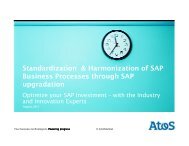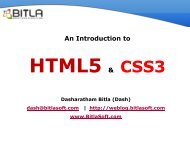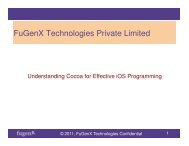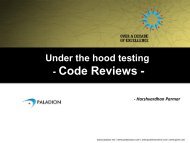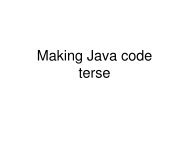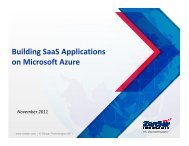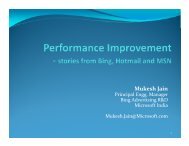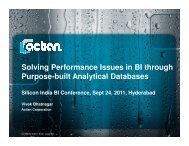ISO 26262 the Emerging Automotive Safety Standard
ISO 26262 the Emerging Automotive Safety Standard
ISO 26262 the Emerging Automotive Safety Standard
You also want an ePaper? Increase the reach of your titles
YUMPU automatically turns print PDFs into web optimized ePapers that Google loves.
<strong>ISO</strong> <strong>26262</strong> <strong>the</strong><br />
<strong>Emerging</strong> <strong>Automotive</strong><br />
<strong>Safety</strong> <strong>Standard</strong>
Agenda<br />
• Introduction of <strong>ISO</strong>/DIS <strong>26262</strong> (<strong>ISO</strong> <strong>26262</strong>)<br />
• Parts of <strong>ISO</strong> <strong>26262</strong><br />
• ASIL Levels<br />
• Part 4 : Product Development – System Level<br />
• Part 6 : Product Development – Software Level<br />
• Fitting software tools into <strong>ISO</strong> <strong>26262</strong> process<br />
2
Introduction of <strong>ISO</strong>/DIS <strong>26262</strong><br />
(<strong>ISO</strong> <strong>26262</strong>)<br />
3
Introduction<br />
<strong>ISO</strong> <strong>26262</strong> is an adaptation of IEC 61508<br />
for <strong>the</strong> automotive industry.<br />
<strong>ISO</strong> <strong>26262</strong><br />
Functional <strong>Safety</strong> in in in<br />
<strong>Automotive</strong><br />
Electronics<br />
IEC 61508 (Industrial)<br />
Functional <strong>Safety</strong> for E/E/PE<br />
<strong>Safety</strong> related systems<br />
EN 50128/EN50129<br />
Rail Transport<br />
IEC 62304<br />
Medical Devices<br />
IEC 670880<br />
Nuclear Power<br />
4
Introduction<br />
• It applies to safety-related road vehicle E/E<br />
systems, and addresses hazards due to<br />
malfunctions, excluding nominal performances of<br />
active and passive safety systems.<br />
• Risk is determined based on customer risk by<br />
identifying <strong>the</strong> so-called <strong>Automotive</strong> <strong>Safety</strong><br />
Integrity Level (ASIL) associated with each<br />
undesired effects.<br />
• It provides ASIL-dependent requirements for <strong>the</strong><br />
whole lifecycle of <strong>the</strong> E/E system (including<br />
Hardware and Software components)<br />
5
Parts of <strong>ISO</strong> <strong>26262</strong><br />
6
<strong>ISO</strong> <strong>26262</strong> Parts<br />
• Part 1 : Vocabulary<br />
• Part 2 : Management of Functional <strong>Safety</strong><br />
• Part 3 : Concept phase<br />
• Part 4 : Product Development: System Level<br />
• Part 5 : Product Development: Hardware Level<br />
• Part 6 : Product Development: Software Level<br />
• Part 7 : Production and Operation<br />
• Part 8 : Supporting Processes<br />
• Part 9 : ASIL-oriented and <strong>Safety</strong>-oriented Analyses<br />
• Part 10 : Guidelines on <strong>ISO</strong> <strong>26262</strong><br />
7
IEC 61508 versus <strong>ISO</strong> <strong>26262</strong><br />
IEC 61508 <strong>ISO</strong>/DIS <strong>26262</strong><br />
Part 1: General requirements Part 1: Vocabulary<br />
Part 2: Requirements for<br />
electrical/electronic/programmable electronic<br />
safety-related systems<br />
Part 2: Management of functional safety<br />
Part 3: Software requirements Part 3: Concept phase<br />
Part 4: Definitions and abbreviations Part 4: Product Development: System Level<br />
Part 5: Examples of methods for <strong>the</strong><br />
determination of safety integrity levels<br />
Part 6: Guidelines on <strong>the</strong> application of parts<br />
2 and 3<br />
Part 7: Overview of techniques and<br />
measures<br />
Part 5: Product Development: Hardware<br />
Level<br />
Part 6: Product Development: Software Level<br />
Part 7: Production and Operation<br />
Part 8: Supporting Processes<br />
Part 9: ASIL-orientated and safety-oriented<br />
analysis<br />
Part 10: Guideline<br />
8
<strong>ISO</strong> <strong>26262</strong> Process<br />
9
ASIL Levels<br />
10
ASIL<br />
• <strong>ISO</strong>/DIS <strong>26262</strong> replaces SILs with ASILs (<strong>Automotive</strong><br />
<strong>Safety</strong> Integrity Levels)<br />
• ASILs designed to specify <strong>the</strong> measures required to avoid<br />
unreasonable residual risk<br />
• ASIL levels A-D, with D being <strong>the</strong> most demanding<br />
• Risk of each hazardous event is evaluated on <strong>the</strong> basis<br />
of:<br />
– Frequency of <strong>the</strong> situation (or “exposure”)<br />
– Impact of possible damage (or “severity”)<br />
– Controllability<br />
11
Part 4 : Product Development –<br />
System Level<br />
12
Part 4 : Product Development – System<br />
Level<br />
After <strong>the</strong> initiation of <strong>the</strong><br />
product development and<br />
specification of <strong>the</strong><br />
technical safety<br />
requirements, <strong>the</strong> system<br />
design is performed.<br />
Depending on <strong>the</strong><br />
complexity of <strong>the</strong><br />
architecture, <strong>the</strong><br />
requirements can be<br />
derived iteratively, and<br />
integrated after <strong>the</strong><br />
Hardware &Software<br />
implementation.<br />
Integrate software &<br />
hardware, validation is<br />
performed to comply with<br />
each safety requirement in<br />
accordance<br />
with its specification and<br />
ASIL classification.<br />
13
4.6 - Specification of <strong>the</strong> Technical<br />
<strong>Safety</strong> Requirements<br />
• Objective is to develop <strong>the</strong> technical safety requirements,<br />
which refine <strong>the</strong> functional safety concept considering <strong>the</strong><br />
preliminary architectural design.<br />
• To verify through analysis that technical safety<br />
requirements comply to <strong>the</strong> functional safety<br />
requirements.<br />
• To bring item-level functional safety requirements into<br />
system-level technical safety requirements, down to <strong>the</strong><br />
allocation to hardware and software elements<br />
14
4.6 - Specification of <strong>the</strong> Technical<br />
<strong>Safety</strong> Requirements<br />
Requirements Engineering of this nature requires<br />
additional initial effort but benefits will be obtained<br />
whenever changes are required.<br />
Cost of a project WITH<br />
Requirements<br />
Engineering<br />
Cost of a project<br />
WITHOUT Requirements<br />
Engineering<br />
Project Start Deliver<br />
(less delay)<br />
Deliver<br />
15
4.7 - System Design<br />
• To develop <strong>the</strong> system design and <strong>the</strong> technical safety<br />
concept that comply with <strong>the</strong> functional requirements and<br />
<strong>the</strong> technical safety requirements specification.<br />
• Verify <strong>the</strong> System design and technical safety concept<br />
comply with Technical safety requirements specification.<br />
• Need to have bidirectional traceability between System<br />
design and Technical safety requirements specification.<br />
16
4.8 - Item integration and testing<br />
• To integrate <strong>the</strong> different parts that compose <strong>the</strong> system,<br />
included o<strong>the</strong>r technologies and/or external entities, and<br />
to test <strong>the</strong> obtained product to comply with each safety<br />
requirement and to verify that <strong>the</strong> design has been<br />
correctly implemented.<br />
• The integration and testing is carried out from<br />
software-hardware integration, and going through<br />
integration of systems up to vehicle integration, with<br />
specific tests performed at each integration phase.<br />
17
4.8 - Item integration and testing<br />
• Each functional and technical safety requirements shall<br />
be tested at least once in <strong>the</strong> complete integration phase.<br />
18
4.9 - <strong>Safety</strong> Validation<br />
• To provide evidence of due compliance with <strong>the</strong> functional<br />
safety goals and that <strong>the</strong> safety concepts are appropriate<br />
for <strong>the</strong> functional safety of <strong>the</strong> item.<br />
• To provide evidence that <strong>the</strong> safety goals are correct,<br />
complete and fully achieved at vehicle level.<br />
• The validation plan shall include:<br />
– 1. The configuration of <strong>the</strong> item<br />
– 2. The specification of test cases and acceptance criteria<br />
– 3. The required environmental conditions<br />
19
4.10 - Functional safety assessment<br />
• To assess <strong>the</strong> functional safety that is achieved by <strong>the</strong><br />
item.<br />
20
4.11 – Release for Production<br />
• To specify <strong>the</strong> criteria for <strong>the</strong> release for production at <strong>the</strong><br />
completion of <strong>the</strong> item development.<br />
• The release for production confirms that <strong>the</strong> item complies<br />
with <strong>the</strong> requirements for functional safety at vehicle level.<br />
• The documentation shall include<br />
– a) <strong>the</strong> name and signature of <strong>the</strong> person in charge of release<br />
– b) <strong>the</strong> version/s of <strong>the</strong> released item<br />
– c) <strong>the</strong> configuration of <strong>the</strong> released item<br />
– d) references to associated documents<br />
– e) <strong>the</strong> release date<br />
21
Part 6 : Product Development –<br />
Software Level<br />
22
Part 6 : Product Development –<br />
Software Level<br />
• <strong>ISO</strong> <strong>26262</strong> (Part 6) refers more specifically to <strong>the</strong><br />
development of software, particularly:<br />
– Initiation of product development at <strong>the</strong> software level<br />
– Derivation of software safety requirements from <strong>the</strong> system level<br />
(following from part 4) and <strong>the</strong>ir subsequent verification<br />
– Software architectural design<br />
– Software unit design and implementation<br />
– Software unit testing, and<br />
– Software integration and testing<br />
23
6.5 Initiation of Product Development<br />
at Software Level<br />
• To plan and initiate <strong>the</strong> functional safety activities for <strong>the</strong><br />
sub phases of <strong>the</strong> software development<br />
24
6.5 Modelling and Coding Guidelines<br />
• To support <strong>the</strong> correctness of <strong>the</strong> design and<br />
implementation, <strong>the</strong> design and coding guidelines for <strong>the</strong><br />
modelling, or programming languages, shall address<br />
following topics:<br />
25
6.6 Specification of Software <strong>Safety</strong><br />
Requirements<br />
• To specify <strong>the</strong> software safety requirements which are<br />
derived from technical safety concept and system design<br />
to detail hardware-software requirements and verify that<br />
<strong>the</strong> software safety requirements are consistent with <strong>the</strong><br />
technical safety concept and <strong>the</strong> system design<br />
specification<br />
• The technical safety requirements are divided into<br />
hardware and software safety requirements. The<br />
specification of <strong>the</strong> software safety requirements<br />
considers constraints of <strong>the</strong> hardware and <strong>the</strong> impact of<br />
<strong>the</strong>se constraints on <strong>the</strong> software.<br />
26
6.6 Verification of Software <strong>Safety</strong><br />
Requirements<br />
• A verification activity shall be performed to demonstrate<br />
that <strong>the</strong> software safety requirements are traceable with<br />
<strong>the</strong> technical safety requirements, <strong>the</strong> system design and<br />
consistent with <strong>the</strong> relevant parts of <strong>the</strong> hardware safety<br />
requirements achieving complete traceability.<br />
27
6.7 Software Design<br />
• To develop a software architectural design that realizes<br />
<strong>the</strong> software safety requirements and verify <strong>the</strong> software<br />
architectural design achieving bi-directional traceability<br />
• The software architectural design represents all software<br />
components and <strong>the</strong>ir interactions with one ano<strong>the</strong>r in a<br />
hierarchical structure.<br />
28
6.7 Software Design<br />
• The software architectural design shall exhibit<br />
– Modularity<br />
– Encapsulation<br />
– Minimum complexity<br />
29
6.7 Verification of Architectural Design<br />
• The software architectural design shall be verified by<br />
using <strong>the</strong> following software architectural design<br />
verification methods:<br />
30
6.8 Software Unit design &<br />
implementation<br />
• To specify <strong>the</strong> software units in accordance with <strong>the</strong> SW<br />
architectural design and <strong>the</strong> associated SW safety<br />
requirements, to implement <strong>the</strong> software units as<br />
specified and to verify <strong>the</strong> design of <strong>the</strong> SW units and<br />
implementation.<br />
• The specification of <strong>the</strong> software units shall describe <strong>the</strong><br />
functional behavior and <strong>the</strong> internal design.<br />
• The design and implementation of software unit shall<br />
achieve<br />
– Avoidance of unnecessary complexity<br />
– Testability<br />
– Maintainability<br />
31
6.8 Software Unit Design<br />
• The design principles for software unit design and<br />
implementation shall be applied to follow below properties<br />
• Correct execution order<br />
• Interface consistency<br />
• Correct data/control flow<br />
• Simplicity<br />
• Readability and<br />
comprehensibility<br />
• Robustness<br />
• Change suitability<br />
• Testability<br />
32
6.8 Verification of software unit design<br />
and implementation<br />
• The software unit design and implementation shall be<br />
verified to demonstrate<br />
• Compliance with <strong>the</strong> hardwaresoftware<br />
interface<br />
• Completeness regarding <strong>the</strong><br />
software safety requirements<br />
and <strong>the</strong> software architecture<br />
through traceability<br />
• Compliance of <strong>the</strong> source code<br />
with its specification<br />
• Compliance of <strong>the</strong> source code<br />
with <strong>the</strong> coding guidelines<br />
• Compatibility of <strong>the</strong> software unit<br />
implementations with target<br />
hardware.<br />
33
6.9 Software Unit Testing<br />
• Software units fulfill <strong>the</strong> software unit specifications and<br />
do not contain undesired functionality.<br />
• The following testing methods can be used for proving<br />
compliance with specification and Hardware Software<br />
interface, correct implementation, absence of unintended<br />
functionality, robustness, and sufficiency of <strong>the</strong> resources.<br />
34
6.9 Test case specification and<br />
structural coverage metrics<br />
• To evaluate <strong>the</strong><br />
completeness of test cases<br />
and to demonstrate that<br />
<strong>the</strong>re is no unintended<br />
functionality, <strong>the</strong> coverage<br />
of requirements at <strong>the</strong><br />
software unit level shall be<br />
determined and <strong>the</strong><br />
structural coverage shall be<br />
measured in accordance<br />
with <strong>the</strong> metrics listed.<br />
35
6.10 SW integration & Testing<br />
• To integrate <strong>the</strong> software components and demonstrate<br />
that <strong>the</strong> software architectural design is correctly realised<br />
by <strong>the</strong> embedded software.<br />
• Integrated software tested against architectural design<br />
and interfaces between <strong>the</strong> software units and <strong>the</strong><br />
software component.<br />
• Software integration test shall demonstrate<br />
– Compliance with <strong>the</strong> software architectural design<br />
– Compliance with <strong>the</strong> specification of <strong>the</strong> hardware-software<br />
interface<br />
– Correct implementation of <strong>the</strong> functionality<br />
– Robustness<br />
– Sufficiency of <strong>the</strong> resources to support <strong>the</strong> functionality.<br />
36
6.11 Verification of SW safety<br />
requirements<br />
• To demonstrate that <strong>the</strong> embedded software fulfils <strong>the</strong><br />
software safety requirements and embedded software<br />
satisfies its requirements in <strong>the</strong> target environment.<br />
• The results of <strong>the</strong> verification of <strong>the</strong> software safety<br />
requirements shall be evaluated in accordance with:<br />
– Compliance with <strong>the</strong> expected results<br />
– Coverage of <strong>the</strong> software safety requirements<br />
– A pass or fail criteria<br />
37
Fitting software tools into <strong>ISO</strong><br />
<strong>26262</strong> process<br />
38
LDRA Compliance with <strong>ISO</strong> <strong>26262</strong><br />
• <strong>ISO</strong>/DIS <strong>26262</strong> is a new standard for <strong>the</strong> <strong>Automotive</strong><br />
sector<br />
– But it is based on principles which have been long established<br />
elsewhere<br />
• The concept of adopting Aerospace development<br />
principles sounds expensive<br />
– But tools to handle <strong>the</strong>se issues are<br />
• Sophisticated and proven, and<br />
• Designed to apply <strong>the</strong>se principles cost effectively<br />
• Similarly, <strong>the</strong> LDRA tool suite have long been established<br />
to provide <strong>the</strong> support for IEC 61508 based principles<br />
39
V Model Process<br />
TBreq ®<br />
Requirements<br />
Traceability<br />
LDRA Testbed ®<br />
& TBvision ®<br />
Programming<br />
standards<br />
checking and<br />
metrication<br />
4.7 System<br />
Design<br />
IBM ® Rational ®<br />
DOORS ® &<br />
RequisitePro ® …<br />
Text Processing<br />
& Office files<br />
4.8 Item integration<br />
& testing<br />
6.6 Specification of<br />
6.11 Verification of<br />
software safety<br />
software safety<br />
requirements requirements<br />
6.7 Software<br />
Architectural<br />
Design<br />
6.8 Software unit<br />
design and<br />
implementation<br />
LDRA Testbed ®<br />
Test and Metrics<br />
Reporting<br />
6.10 Software<br />
integration and<br />
testing<br />
6.9 Software unit<br />
testing<br />
LDRA<br />
Testbed ®<br />
Test<br />
Verification<br />
TBrun ®<br />
Automated<br />
Unit<br />
Testing<br />
40
Static Analysis<br />
41
Coding <strong>Standard</strong> Enforcement<br />
• JPL<br />
• MISRA<br />
• MISRA-C:2004<br />
• NETRINO<br />
• RUNTIME<br />
• CERT<br />
• CMSE<br />
• CONFORM<br />
• CWE<br />
• DERA<br />
• EADS<br />
• JSF++ AV<br />
• MISRA C++:2008<br />
42
Cyclomatic Complexity<br />
43
Software Architectural Design<br />
44
Data Flow and Control Flow<br />
45
Software Unit Testing<br />
Topics<br />
A B<br />
ASIL<br />
C D<br />
1a Requirement-based test ++✔ ++✔ ++✔ ++✔<br />
1b Interface test ++✔ ++✔ ++✔ ++✔<br />
1c Fault injection test +✔ +✔ +✔ ++✔<br />
1d Resource usage test + + + ++<br />
1e Back-to-back test between model and code, if<br />
applicable<br />
+ + ++ ++<br />
Topics<br />
A B<br />
ASIL<br />
C D<br />
1a Analysis of requirements ++✔ ++✔ ++✔ ++✔<br />
1b Generation and analysis of equivalence<br />
classes<br />
+✔ ++✔ ++✔ ++✔<br />
1c Analysis of boundary values +✔ ++✔ ++✔ ++✔<br />
1d Error guessing +✔ +✔ +✔ +✔<br />
”++” The method is highly recommended for this ASIL.<br />
“+“ The method is recommended for this ASIL.<br />
“o“ The method has no recommendation for or against its usage for this ASIL.<br />
✔Satisfied by <strong>the</strong> LDRA tool suite<br />
46
Unit Test Case Execution<br />
47
Coverage Analysis<br />
Topics<br />
A B<br />
ASIL<br />
C D<br />
1a Statement coverage ++✔ ++✔ +✔ +✔<br />
1b Branch coverage +✔ ++✔ ++✔ ++✔<br />
1c MC/DC (Modified Condition/Decision<br />
+✔ +✔ +✔ ++✔<br />
Coverage)<br />
”++” The method is highly recommended for this ASIL.<br />
“+“ The method is recommended for this ASIL.<br />
“o“ The method has no recommendation for or against its usage for this ASIL.<br />
✔Satisfied by <strong>the</strong> LDRA tool suite<br />
Topics<br />
A B<br />
ASIL<br />
C D<br />
1a Function coverage +✔ +✔ ++✔ ++✔<br />
1b Call coverage +✔ +✔ ++✔ ++✔<br />
”++” The method is highly recommended for this ASIL.<br />
“+“ The method is recommended for this ASIL.<br />
“o“ The method has no recommendation for or against its usage for this ASIL.<br />
✔Satisfied by <strong>the</strong> LDRA tool suite<br />
48
Coverage Analysis<br />
49
Traceability Matrix<br />
• Forward and Backward<br />
Traceability<br />
50
Software Lifecycle Traceability<br />
TBreq ®<br />
Requirements<br />
Traceability<br />
TBmanager ®<br />
System Test<br />
Management<br />
TBmanager ®<br />
Unit Test<br />
Management<br />
Telelogic DOORS ® ,<br />
IBM ® Rational ®<br />
RequisitePro ® …<br />
Tier 2<br />
Modelling Tool<br />
Tier 3<br />
Tier 1<br />
High-Level<br />
Requirements<br />
Requirements Traceability Matrix<br />
Legacy Code/<br />
Architectural<br />
Concepts<br />
Requirements Traceability Matrix<br />
Implementation<br />
(Source Code / Assembly)<br />
Requirements Traceability Matrix<br />
Tier 4<br />
Host Tier<br />
(Node 1 – n)<br />
Requirements Traceability Matrix<br />
Tier 5<br />
Target Tier<br />
(Node 1 – n)<br />
Software Specs<br />
Hand Code<br />
LDRA Testbed ®<br />
Design Review<br />
Defects<br />
TBvision ®<br />
Code Review<br />
Defects<br />
TBrun ®<br />
Host<br />
Testing<br />
TBrun ®<br />
Target<br />
Testing<br />
51
Conclusion<br />
• IEC <strong>26262</strong> ensures <strong>the</strong> safety of <strong>the</strong> electrical / electronic<br />
/ programmable electronic devices in Road vehicles.<br />
• Using tools with a proven track record and pedigree to<br />
automate <strong>the</strong> software development process:<br />
– Will help in producing safe product<br />
– Provides confidence to <strong>the</strong> manufacturers<br />
– Save time and money<br />
52
For fur<strong>the</strong>r information visit:<br />
www.ldra.com<br />
india@ldra.com<br />
53



